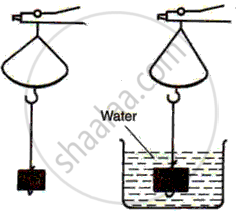Advertisements
Advertisements
Question
Solution
We can find the relative density of a solid denser than water by following the experiment.

Weighing a solid in air and water
Find the weight (W1 gf) of a solid in the air using a hydrostatic balance.
Tie the solid firmly with a thread and suspend it from the hook. Lower the solid in water and find its weight.
Record the result as shown below:
Weight of solid in air = w1 gf.
Weight of solid in water = W2 gf.
The apparent loss of weight of solid = (W1 - W2 ) gf.
Relative density = W1/ (W1 - W2)
The relative density of the solid = (weight of solid in the air )/(Apparent loss of weight of solid in water).
APPEARS IN
RELATED QUESTIONS
Draw a diagram to show the forces acting on a body floating in water with its some part submerged. Name the forces and show their points of application. How is the weight of water displaced by the floating body related to the weight of the body itself?
Why is the floating ice less submerged in brine than in water?
A piece of ice floating in a glass of water melts, but the level of water in the glass does not change.
Give reasons.
Hint: Ice contracts on melting.
A body floats in a liquid A of density ρ1 with a part of it submerged inside the liquid, while in liquid B of density ρ2 it is totally submerged inside the liquid. The densities ρ1 and ρ2 are related as :
A test tube loaded with lead shots, weighs 150 gf and floats upto the mark X in water. The test tube is then made to float in alcohol. It is found that 27 gf of lead shots have to be removed, so as to float it to level X. Find R.D. of alcohol.
Why does a ship make of iron not sink in water, while an iron nail sinks in it?
A rubber ball floats in water with 2/7 of its volume above the surface of the water. Calculate the average relative density of the rubber ball.
Name an instrument based on this principle. State two uses of the instrument that you describe.
How do submarines sink and float in water?
Describe the purpose, principle, and working of the Lactometer.
